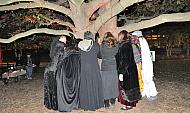Sulphur Springs, West Asheville
The healing spring that gave rise to West Asheville was Western North Carolina's first tourist attraction. Once frequented by the Cherokee, the natural mineral waters of Sulphur Springs were rediscovered by settler Robert Henry and his slave Sam in February 1827. The springs became one of the most popular resort spots in the South -- and the Asheville region's first tourist destination -- after Col. Reuben Deaver built a 250-room hotel nearby in 1830. His Sulphur Springs Hotel burned down in 1862, but in 1887 the wealthy Philadelphia-born developer and philanthropist Edwin Carrier built a deluxe three-story hotel, the Belmont, on the same spot. Although it too was soon destroyed by fire, for many years after "the Sulphur Springs remained a popular spot for picnics, carriage and tallyho trips," according to George Pennell ("Traipsin' in West Asheville").
Today, an arched eight-sided pavilion enclosing the spring still stands. It appears to date from Carrier's era. Does the spring still flow? I don't know: As you can see, the well appears blocked inside by rubble, but water is pooled around it. On a previous summertime visit some years ago, I could smell sulphur strongly in the area, but this time (a cool winter day) I did not detect any odor.
This key piece of Asheville history -- the very point of origin of West Asheville -- is overgrown and neglected, yet still mysteriously beautiful. It should be archaeologically investigated, and then carefully restored, and the healing springs ought to be set free to flow again.
I took these photos on Feb. 24, 2011. For the spring's protection, I will avoid revealing its location here.
Today, an arched eight-sided pavilion enclosing the spring still stands. It appears to date from Carrier's era. Does the spring still flow? I don't know: As you can see, the well appears blocked inside by rubble, but water is pooled around it. On a previous summertime visit some years ago, I could smell sulphur strongly in the area, but this time (a cool winter day) I did not detect any odor.
This key piece of Asheville history -- the very point of origin of West Asheville -- is overgrown and neglected, yet still mysteriously beautiful. It should be archaeologically investigated, and then carefully restored, and the healing springs ought to be set free to flow again.
I took these photos on Feb. 24, 2011. For the spring's protection, I will avoid revealing its location here.


